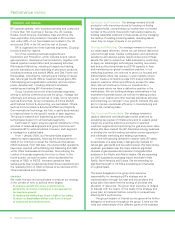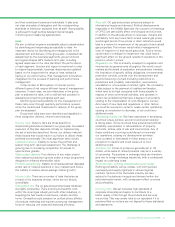BP 2005 Annual Report Download - page 20
Download and view the complete annual report
Please find page 20 of the 2005 BP annual report below. You can navigate through the pages in the report by either clicking on the pages listed below, or by using the keyword search tool below to find specific information within the annual report.
18 Making energy more
updates, revises and summarizes BP’s standards for
employee conduct in a single framework. The code is the
centrepiece of our group compliance programme, being
developed and overseen by the central GC&E function.
One hundred and thirty-five senior level compliance and
ethics leaders within BP take the lead in activities to ensure
that the code is effectively implemented throughout the
group. We have also enhanced our employee concerns
programme, OpenTalk, to enable employees to seek
guidance on the code. We believe these steps have resulted
in the number of cases raised through OpenTalk increasing
from 343 in 2004 to 634 in 2005. After the code launch
on 15 June 2005, there were 490 cases to the end of the
year, compared with 224 in the same period of 2004.
Our processes are designed to choose suppliers
carefully, on merit, avoiding conflicts of interest and
inappropriate gifts and entertainment. We expect suppliers
to comply with legal requirements and we seek to do
business with suppliers who act in line with BP’s
commitments to compliance and ethics, as outlined
in the code of conduct.
Our mechanisms for managing relationships with
suppliers focus on strategy, building common ground,
delivery and performance management. We engage with
suppliers in a variety of ways, including performance review
meetings to identify mutual improvements in performance.
We apply a strict anti-corruption policy, including a
prohibition on making facilitation payments, which is now
incorporated in the code of conduct. We take steps to
identify and correct areas of non-compliance and take
disciplinary action where appropriate. In 2005, this included
the reported dismissal of 478 people for non-compliance
or unethical behaviour, including breaches of BP’s health,
safety, security and the environment (HSSE) policies, fraud,
theft and dishonesty. (This number excludes retail site staff
dismissals for ‘petty’ incidents.)
The code of conduct outlines our policy not to make
corporate political donations anywhere in the world. BP
specifically made no contributions to UK or other EU political
parties or organizations in 2005.
Safety and operational integrity In total, there were
27 workforce fatalities in the course of BP operations
during 2005. We deeply regret the loss of these lives. This
was the worst year for BP’s safety record since 1999, when
there were 30 workforce fatalities. Fifteen of the deaths in
2005, as well as many injuries, resulted from an explosion
and fire at the Texas City refinery. There were 12 other
workforce fatalities in BP’s operations, 10 of which were
transport-related.
During 2005, there were 305 reported days away from
work injury cases, of which 120 resulted from the Texas City
incident. This compares with 230 cases in 2004 and 461
in 1999. An additional 1,139 reported injuries in 2005
required medical treatment, apart from minor cuts and
bruises. Combining all the injuries and fatalities, our total
recordable injury frequency for 2005 was 0.53 in 2005
(per 200,000 hours worked), compared with 0.53 in 2004
and 1.42 in 1999.
The Texas City incident happened on 23 March 2005 in
an isomerization unit used to make components for unleaded
gasoline. BP has set aside $700 million in compensation
and has reached settlements with many of the injured and
bereaved. BP has also entered into a settlement with the
US Occupational Safety and Health Administration (OSHA)
to resolve more than 300 separate alleged violations of OSHA
safety regulations. BP paid a fine of $21.3 million and agreed to
a number of corrective actions. Under the agreement, BP does
not admit the alleged violations or agree with the way OSHA
has characterized them.
BP Products North America Inc. issued a final incident
investigation report in December 2005 outlining the underlying
causes of the incident. BP is undertaking corrective actions
at the refinery as part of a settlement reached with OSHA
and in response to the recommendations of BP’s Joint
Incident Investigation Committee’s interim and final reports.
The company expects to invest an estimated $1 billion to
improve and maintain the site during the next five years.
Following a further fire in July and a leak from another
unit at Texas City in August, the US Chemical Safety and
Hazard Investigation Board issued an urgent recommendation
that BP appoint an independent panel to study the safety
culture of its US refineries. This panel started work under
the chairmanship of former US Secretary of State
James A Baker III.
The incident at Texas City led to a fundamental review
of the systems, processes and organization needed to
increase further the focus on safety and operational issues in
our US refineries and across BP. We have introduced a new
organizational structure to focus on these issues, including a
new senior group vice president for safety and operations,
a role filled by the senior executive who led the investigation
into the Texas City incident. This team has drawn up plans for
measures in three areas: plant, people and processes.
In terms of plant, we have been carrying out a
programme of major accident risk assessments for our
major plant and equipment and plan to invest more than
$3.5 billion in integrity management at our sites during the
next five years. We also plan to improve operating plant
processes and clarify engineering authorities.
In terms of people, we aim to improve the safety and
operational culture for all our people, including work to
LONG-TERM SAFETY PERFORMANCE (DAFWCF)a 1988-2005
1.5
1.0
0.5
0.0
88 92 96 00 05
a
Days away from work case frequency (DAFWCF) is the annual
frequency (per 200,000 hours) of injuries that result in a person
(employee or contractor) being unable to work for a day (shift) or more.
For a full understanding of the underlying data on reported DAFWCF,
please refer to our website.
























